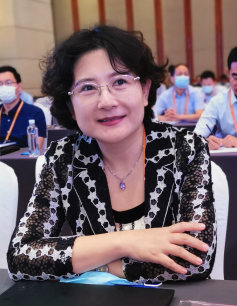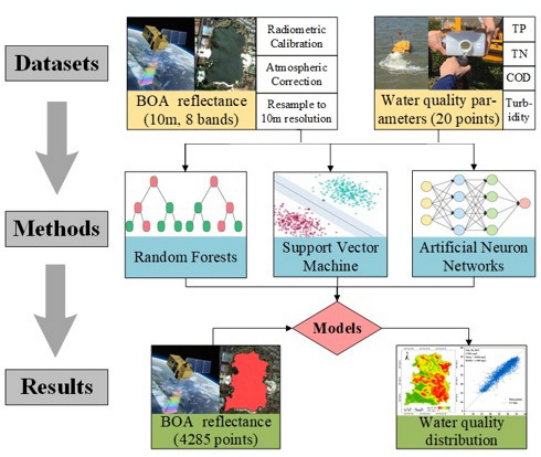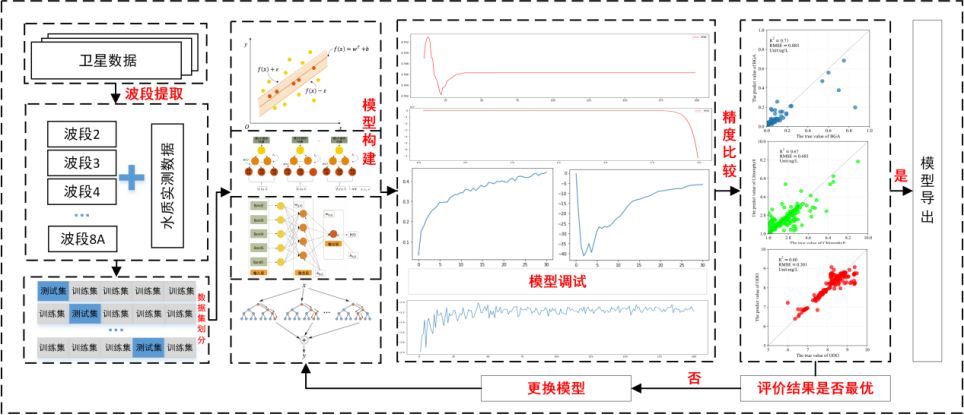
文章导读
学者简介
研究方向及意义
研究进展
未来研究关注重点
近期发表的文献
一、学者简介

黄津辉,南开大学教授、博士生导师,现任南开大学中加水与环境安全联合研发中心主任;加拿大水技术交流中心副主任;加拿大土木工程学会国际事务委员会主席(终身会员);是国际综合水资源管理领域的专家。项目遍及加拿大,美国,南美国家和阿拉伯地区,有非常丰富的科研及工程经验。从2010年起,她将低影响开发LID的理念在中国的水系规划和水生态修复中推广,在国内推广非点源污染的控制手段;她还在世界各地包括法国,加拿大,韩国等地讲授城市水文和低影响开发模拟及设计,并对数字模拟城市河流水量水质有丰富的经验,是国际上该领域的著名专家。从2012年开始,被IAHR的会员选为水信息Hydroinformatics 领域的World Leadership Team中的一员,是中国第一位被选入该领导团队的学者。2015年,还被推举为加拿大土木工程学会的Fellow, 是加拿大工程学界非常高的荣誉。黄津辉教授于2010年获中国教育部新世纪优秀人才,2011年获得水利部大禹奖一等奖。
二、研究方向及意义
三、研究进展
选用高时空分辨率的Sentinel-2影像,借助、对比多种机器学习算法,构建了一种城市小型水体P、TN、COD和Turbidity四种水质参数定性监测的方法。

关注于城市化背景下,人类干扰活动对于近岸海域水生态系统的影响,评估了不同模型对于光敏和非光敏水质参数反演的适用性。

针对水环境中的13种常见PSP毒素,采用全自动化在线固相萃取-超高效液相色谱-串联质谱(On-line SPE-UPLC-MS/MS)技术,通过对水体中PSP毒素On-line SPE自动富集、洗脱以及UPLC-MS/MS检测条件的系统优化,建立一种同步快速检测水生环境中多种典型PSP毒素的新方法。

四、未来研究关注重点
五、近期发表的文献
1. Hongwei Guo, Jinhui Jeanne Huang, Bowen Chen, Xiaolong Guo & Vijay P.Singh (2021). A machine learning-based strategy for estimating non-optically active water quality parameters using Sentinel-2 imagery, International Journal of Remote Sensing, 42:5,1841-1866.
2. Chen, H., Huang, J.J*., McBean, E. (2020a). Partitioning of daily evapotranspiration using a modified shuttleworth-wallace model,random Forest and support vector regression, for a cabbage farmland. Agricultural Water Management, 228,105923.
3. Chen, H., Huang, J.J*., Wang, K., McBean, E. (2020b). Quantitative Assessment of Agricultural Practices on Farmland Evapotranspiration Using Eddy Covariance Method and Numerical Modelling. Water Resources Management,doi:10.1007/s11269-019-02448-9. https://doi.org/10.1007/s11269-019-02448-9.
4. Chen, H., Huang, J.J*., Berg, A., McBean, E. (2020c). Development of a Trapezoidal Framework-Based Model (PCALEP) for Partition of Land Evapotranspiration. Journal of Hydrology.124994,0022-1694. https://doi.org/10.1016/j.jhydrol.2020.124994.
5. Chen, H., Huang, J.J*., McBean, E., Singh, V. (2020d). Evaluation of alternative two-source remote sensing models in partitioning of land evapotranspiration. Journal of Hydrology. 124994, 0022-1694.
6. Huang, J.J*., Chen, H., Li, T.T., McBean, E., Singh, V. (2020e). A Modified Trapezoid Framework Model for Partitioning Regional Evapotranspiration. Hydrological Processes.
7. Wang, J., Huang, J.J.* and Li, J. (2020); Characterization of the Pollutant Build-up Processes and Concentration/Mass Load in Road Deposited Sediments over a Long Dry Period, Science of The Total Environment, DOI:10.1016/j.scitotenv.2020.137282
8. Wang, J., Huang, J.*, Li, J., (2019). A Study of Road Sediment Build-up Processes in a Long Dry Period in Semi-Arid Area of China, Science of the Total Environment, Volume 696, 15 December 2019, https://doi.org/10.1016/j.scitotenv.2019.133788.
9. Liu, B., Huang, J*., and McBean, E. A. (2019). Risk Assessment of Hybrid Rain Harvesting System and Other Small Drinking Water Supply Systems by Game Theory and Fuzzy Logic Modelling, Science of Total Environment, https://doi.org/10.1016/j.scitotenv.2019.134436.
10. Xiao, N., Wu, R., Huang J.*and Selvaganapathy, P.; (2020). Influence of wastewater microbial community on the performance of miniaturized microbial fuel cell biosensor, Bioresource Technology,https://doi.org/10.1016/j.biortech.2020.122777.
11. Xiao, N., Wu, R., Huang J.*and Selvaganapathy, P. (2019). Development of a xurographically fabricated miniaturized low-cost, high-performance microbial fuel cell and its application for sensing biological oxygen demand, Sensors & Actuators: B. Chemical , https://doi.org/10.1016/j.snb.2019.127432.
12. Xiao, N., Wu, R., Huang J.*and Selvaganapathy, P. (2020). Anode surface modification regulates biofilm community population and the performance of micro-MFC based biochemical oxygen demand sensor,Chemical Engineering Science.
13. Ali, S., Hua, B., Huang, J.*, Droste., R, Zhou, Q., Zhao, W., (2019). Effect of different initial low pH conditions on biogas production, composition, and shift in the aceticlastic methanogenic population, Bioresources Technology, https://doi.org/10.1016/j.biortech.2019.121579.
14. Huang, J. Tian,Y., Wang, R. ,Tian, M., Liao, Y (2019). Fabrication of bead-on-string polyacrylonitrile nanofibrous air filters with superior filtration efficiency and ultralow pressure drop, SEPARATION AND PURIFICATION TECHNOLOGY, doi.org/10.1016/j.seppur.2019.116377.
15. Liao, Y., Zheng, G., Huang, J.*, Tian, M., Wang, R., (2020). Development of robust and superhydrophobic membranes to mitigate membrane scaling and fouling in membrane distillation, Journal of Membrane Science, https://doi.org/10.1016/j.memsci.2020.117962.
16. Huang, J. , Zhang, N., Choi, G., McBean, E. A., and Zhang, Q.(2018). Spatiotemporal Patterns and Trends of Precipitation and Their Correlations with Related Meteorological Factors by Two Sets of Reanalysis Data in China, Hydrol. Earth Syst. Sci. Discuss., https://doi.org/10.5194/hess-2017-756,
17.Wen, Y., Kuang, D., Huang J. and Zhang, Yi; (2017). Microaxicave Colour Analysis System for Fluoride Concentration using a Smart Phone. RSC Advances, 2017,7,42339 (DOI: 10.1039/c7Ra07727k).
18.McBean,E.,Salsali,H.,Bhatti,M.,andHuang,J.*;(2019).Source Characterization of Disinfectants in Municipal Wastewaters, Acta Chimica and Pharmceutica Indica.
19.Huang, J*., Li, Y.; Yin, J.; McBean, E.; (2016). Precipitation Regional Extreme Mapping as a Tool for Ungauged Areas and the Assessment of Climate Changes, Hydrological Processes, 30, 1940–1954 (DOI: 10.1002/hyp.10743) .
20.Huang, J*., Lin, X.; Wang, H.; Wang, J.; (2015). The precipitation driven correlation based mapping method (PCM) for identifying the critical source areas of non-point source pollution, Journal of Hydrology, Volume 524, May 2015, Pages 100–110,doi:10.1016/j.jhydrol.2015.02.011.
21.Zhang, Y., Huang, J*., Chen, L., Qi, L., (2015). Eutrophication Forecasting and Management by Artificial Neural Network: a Case Study at Yuqiao Reservoir in North China, Journal of Hydroinformatics, 17(4),Pages 679–695,doi:10.2166/hydro.2015.115.
22.Huang, J*., and Xiang, W.; (2015). Investigation of Point Source and Non-Point Source Pollution for Panjiakou Reservoir in North China by Modelling Approach, Water Quality Research Journal of Canada,V50(2),pp 167–181,doi: 10.2166/wqrjc.2014.019.
23. Huang, J*., Du, M. ;McBean, E.; Wang, H.; Wang, J-H (2014). A coupled Bayesian and fault tree methodology to assess future groundwater conditions in light of climate change, Hydrology and Earth System Sciences (Discussion) 11, 9361–9397, 2014 , doi:10.5194/hessd-11-9361-2014.
24. Huang, J*., Gao, X.; Balch, G.; Wootton, B.; Jorgensen, S.; Anderson, B.; (2014). Modelling of Vertical Flow Constructed Wetlands for Treatment of Domestic Sewage and Stormwater Runoff by SubWet 2.0, Ecological Engineering, 74, 8-12;http://dx.doi.org/10.1016/j.ecoleng.2014.10.027.
25. Huang, J*., Li, Y.; Niu, S.; Zhou, S.; (2014). Assessing the Performances of LID Alternatives by Long Term Simulation for Semi-Arid Area in Tianjin, Northern China, Water Science and Technology. 2014;69(3):566-572. doi:10.2166/wst.2014.228.
26. Zhang, C, McBean, E., and Huang, J. (2014) “A Virtual Water Assessment Methodology For Cropping Pattern Investigation”, Water Resources Management, June 2014, Volume 28, Issue 8, pp 2331-2349 (SCI, IF2.463), DOI 10.1007/s11269-014-0618-y.
27. Qi, L., Zhang, Y., Peng, J., Qi, C., Huang, J. and Liu, D., (2014). Water requirement of vegetation and infiltration method to determine ecological water requirement of dried up, Water Science and Technology 2014;69(3):566-572. doi: 10.2166/wst.2013.743.
28. Li, T. and Huang, J*., (2014). Separation of Soil Evaporation And Vegetation Transpiration By MODIS Data For Central And Northern China. CUNY Academic Works. http://academicworks.cuny.edu/cc_conf_hic/172.





